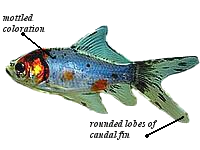Shubunkin: Difference between revisions
imported>John Stephenson (rm image with no attribution) |
imported>John Stephenson (rm image which is probable copyvio) |
||
| Line 30: | Line 30: | ||
Image:LondonShubunkin.jpg|A London Shubunkin | Image:LondonShubunkin.jpg|A London Shubunkin | ||
Image:AmericanShubunkin.jpg|An American Shubunkin | Image:AmericanShubunkin.jpg|An American Shubunkin | ||
</gallery> | </gallery> | ||
{{:Shubunkin/Related Articles}} | {{:Shubunkin/Related Articles}} | ||
{{:Shubunkin/Bibliography}} | {{:Shubunkin/Bibliography}} | ||
Revision as of 03:48, 21 January 2011
| Shubunkin | |
|---|---|

| |
| Family | Cyprinidae |
| Size | Variable |
| Tank Level | All |
| Temperament | Peaceful, Schooling |
| Tail Type | Single-tailed |
| Country of Origin | Japan |
For an in depth tutorial, see our guide
Also known as "poor mans Koi", the Shubunkin is a breed of goldfish first developed in Japan in the 1900's.
Physical Description
The bodies of the Shubunkin varieties are slightly shorter than those of the Common Goldfish, but they are similarly rounded. Shubunkin coloration depends very much on strain and on scale formation: the popular strains tend to show blacks, reds, purples, blues, and browns beneath pearly matte scales. The strain shown at right is the Bristol Shubunkin, which features an extravagant caudal fin. Its pronounced rounded lobes are carried without drooping on a good specimen.
Another popular strain, the London Shubunkin, is the same shape as the Common Goldfish, but it is multi-colored and lacks the metallic scales. Its fins are not artificially developed.
History
The Shubunkin was first bred from mutations in Moor goldfish in the 1900's in Japan. They are commonly referred to as "poor mans Koi", due to the similar coloration and body shape.
In the aqaurium
The Shubunkin behaves much like the Koi, in that it does better outdoors than in an aquarium. Shubunkin are very hardy, and will eat all the foods of typical goldfish.
Gallery
Related Topics
Parent topics
 Fish: Any aquatic vertebrate animal that is typically ectothermic (or cold-blooded), covered with scales, and equipped with two sets of paired fins and several unpaired fins. [e]
Fish: Any aquatic vertebrate animal that is typically ectothermic (or cold-blooded), covered with scales, and equipped with two sets of paired fins and several unpaired fins. [e] Animal: A multicellular organism that feeds on other organisms, and is distinguished from plants, fungi, and unicellular organisms. [e]
Animal: A multicellular organism that feeds on other organisms, and is distinguished from plants, fungi, and unicellular organisms. [e] Organism: An individual living individual: a complex, adaptive physical system that acts a integrated unit that sustains metabolism and reproduces progeny that resemble it. [e]
Organism: An individual living individual: a complex, adaptive physical system that acts a integrated unit that sustains metabolism and reproduces progeny that resemble it. [e]- Chordata: Add brief definition or description
- Osteichthyes: Add brief definition or description
- Actinopterygii: Add brief definition or description
- Neopterygii: Add brief definition or description
- Teleostei: Add brief definition or description
- Ostariophysi: Add brief definition or description
- Cypriniformes: Add brief definition or description
- Cyprinioidea: Add brief definition or description
- Cyprinidae: Add brief definition or description
- Carassius: Add brief definition or description
Subtopics
 Comet (goldfish): A goldfish variety developed in 1880 by Hugo Mulertt, and has become one of the best selling aquarium fish since. [e]
Comet (goldfish): A goldfish variety developed in 1880 by Hugo Mulertt, and has become one of the best selling aquarium fish since. [e] Nymph (goldfish): A breed of goldfish descended from the Veiltail and Fantail. [e]
Nymph (goldfish): A breed of goldfish descended from the Veiltail and Fantail. [e] Common Goldfish: Common ancestor for most "fancy goldfish". Color is the only difference between the Common Goldfish and its ancestor, the Prussian Carp. [e]
Common Goldfish: Common ancestor for most "fancy goldfish". Color is the only difference between the Common Goldfish and its ancestor, the Prussian Carp. [e] Bubble-eye Goldfish: A breed of Goldfish that sports large fluid filled sacs beneath the eyes, a twin tail, and lacks a dorsal fin. [e]
Bubble-eye Goldfish: A breed of Goldfish that sports large fluid filled sacs beneath the eyes, a twin tail, and lacks a dorsal fin. [e]- Celestial Goldfish: Add brief definition or description
- Fantail Goldfish: Add brief definition or description
- Lionhead (goldfish): Add brief definition or description
- Moor (goldfish): Add brief definition or description
- Red-cap Oranda: Add brief definition or description
- Pearlscale (goldfish): Add brief definition or description
- Pom-pom (goldfish): Add brief definition or description
- Veiltail (goldfish): Add brief definition or description
- Japanese Moor: Add brief definition or description
- Red and White Lionhead: Add brief definition or description
- Comet Shubunkin: Add brief definition or description
- Red Ryukin: Add brief definition or description
- Red and White Ryukin: Add brief definition or description
- Red Ranchu: Add brief definition or description
- Red and White Wakin: Add brief definition or description
- Bubble-eye Goldfish [r]: A breed of Goldfish that sports large fluid filled sacs beneath the eyes, a twin tail, and lacks a dorsal fin. [e]
- Anti-intellectualism [r]: Add brief definition or description
Bibliography
- Rogers,Geoff. Freshwater Aquarium Fish. 1 ed. Focus on. Buffalo, New York: Firefly Books
- LTD., 2004.
- Mills,Dick. Aquarium Fish. 1 ed. Eyewitness Handbooks. New York, New York: Dorling
- Kindersley, Inc., 1993.
- Bailey,Mary. Aquarium Fish & Fish Care. paperback ed. The Ultimate Encyclopedia of. New
- York, New York: Hermes House, 1999.




